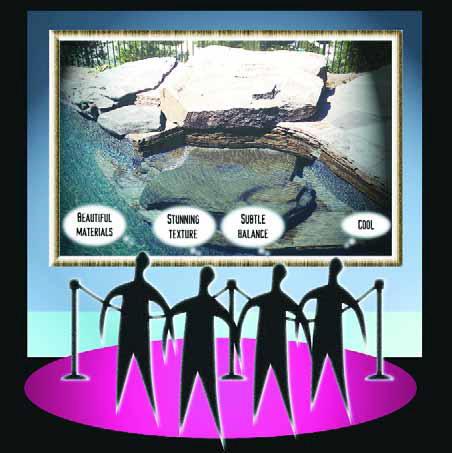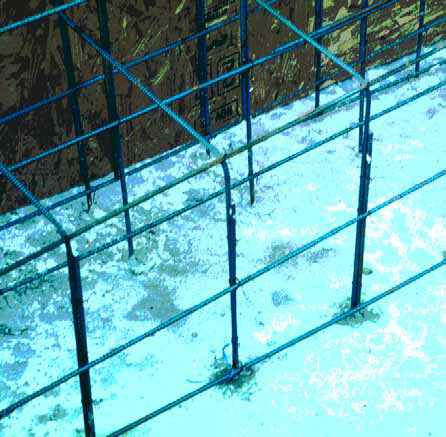Professional Watershaping
In one way or another, visual acceptance is what makes our world go around. Think about the clothes we wear, the cars we admire, the foods we eat - not to mention interior design, home and office furnishings, landscapes and watershapes. So much of our response to these and other features of our environment is based on the visual. It may sometimes be a shallow response, but human beings tend to like things that look good, even if they don't completely understand why some things are visually appealing and others are not. Design education teaches us that
Of all the things I've learned in my work as a watershape designer and builder, one particular point stands out: When it comes to ensuring quality results and a project's success, there's absolutely no substitute for good supervision! I say this knowing that most job sites run by people in the pool industry are inadequately supervised if they're supervised at all. Yet experience shows, time and time again, that while complete, professional plans are part of success and that great subcontractors are essential, constant oversight is the absolute
One of my least favorite activities is testifying as an expert witness in legal disputes over watershaping projects gone awry. As a rule, I try to stay out of courtrooms for any reason, but from time to time, I reluctantly agree to offer my opinion as a witness if I think I can help generate a fair outcome. Despite my best intentions, however, I seldom see it as time well spent. The process is often stressful, and I know deep down, regardless of who's right and who's wrong, that lawsuits are
At nearly five months and counting, it's clear that many of us are still trying to sort out, understand and learn to live with the events of September 11, 2001 - and I suspect that, on some levels, we will be doing so for months or even years to come. Over and over again, we've been told how our lives are now different. Although it'll still take us a while to find out what "different" really means, we know already that we've lost a certain amount of innocence. We've also lost a certain naiveté about the way things are in the wide world and are now reevaluating many things, from big important issues such as airport security to more modest concerns such as
Whenever I'd call my mother on the phone when I was a kid, she'd start the conversation by asking me, "Are you smiling?" Back then, I never gave her greeting too much thought because that's what young people do: They ignore their parents' wisdom until they realize at some point just how smart the old folks could be. As I've grown older and gained experience in business and life in general, it has occurred to me that my mom's question is important and even a bit profound. At first blush, this notion of smiling on the phone is sort of silly. After all, no one sees your face when you're on the phone, so who cares about the expression on your face? But the truth is, this question of whether or not you're smiling on the phone has everything to do with
People who know me are aware of the fact that I can be quite outspoken. They know I've been extremely critical of the pool and spa industry and have made it my crusade to argue that, as an industry, we need to elevate our game. My particular concern lately has to do with the areas of design and presentation. Before I get started, please note that what I'm about to say is directed mainly to readers who come to WaterShapes through what is traditionally labeled as the pool and spa industry. (To be sure, this information should also be of interest to those of you who come to watershaping from the landscape industry because it
I've always been excited by innovation. I place creativity high on my list of aspirations and priorities in my own business, and I think my life gets most interesting when I'm involved with people who are similarly attuned to this desire to do and try new and interesting things. Fortunately, I've had the benefit of associating with highly innovative people through the years who've shared the creative process with me, taught me a lot and made the ride extremely enjoyable - and fruitful. These experiences have filled me with a desire to be out front myself with innovative and creative ideas. I often wonder where we would all be if some of us weren't willing to
Whether it's done using only a tape measure and a pair of experienced eyeballs or requires the help of satellites orbiting the planet, every construction project is surveyed before the work begins. In fact, surveyors have been plying their trade for thousands of years, and their services have been valued for one simple reason: It's really a good idea to measure the size and shape of the ground before you try to build on it. In today's terms, surveying is defined as the process of taking accurate measurements of the land on the X-, Y- and Z axes (that is, in three dimensions) and then translating that data into a usable (usually printed) format. There are several different surveying methods used to measure, process and communicate this critical information, and choosing the right one is essential to getting any watershaping project off to a sound start. So how do you determine the level of detail required and communicate your need to the surveyor so he or she can give you the appropriate level of information? Let's take a look at the different types of surveys in common use and review what those options mean in terms of creating a truly useful array of
I started my May 2001 column by expressing the belief that watershape designers should be paid for their designs in the same way interior designers and landscape designers are paid for theirs - and by indicating that lots of watershapers I've met are interested in knowing more about the mechanics of how this works. I put off addressing those issues last time because I saw a need to establish criteria for offering such services in the first place. In other words, there's much more to being a watershape designer than simply declaring yourself to be one, and I set up two dozen questions intended to clarify what I meant. Once you've answered those questions predominantly in the affirmative, once you've determined, through
In October 1999, I wrote an Aqua Culture column titled "Value by Design" in which I explained my belief that watershape designers should be paid for their designs in the same way interior designers and landscape designers are paid for theirs. Since then, I've been contacted by lots of people who are interested in knowing more about how this works; I've also had the privilege of traveling throughout the United States and abroad to talk about watershape design and construction and have met hundreds of people with the same need for information. On the one hand, it's exciting to see the notion of a watershape-design specialty catching on: It isn't a foreign idea to people the way it used to be, and






















